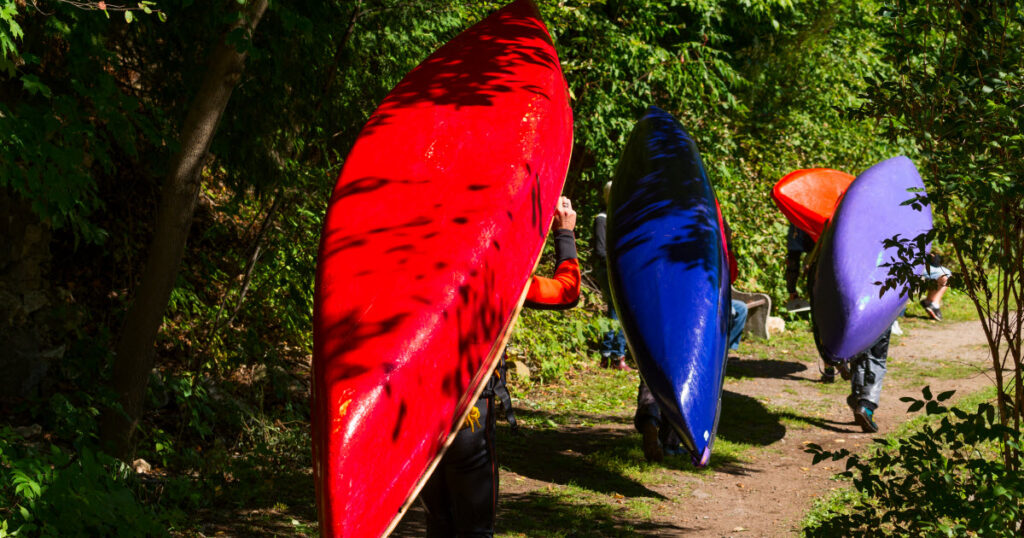So, you’re new to canoeing and you’ve heard people in the know throw around the word “portage.” If you’re like I was as a beginner, you haven’t asked “what’s portage” because you didn’t want to seem totally clueless. Luckily, I’m here to let you into the secrets of canoe portage. So, let’s get down to it. What’s canoe portage? And why does it matter?
Portage is actually quite simple: it means carrying or transporting your canoe. If you’re eager to start canoeing, canoe portage is a must.
But how do you do canoe portage? Are there helpful techniques? What tips and tricks do you need to know? Keep reading to find out.
The History of Canoe Portage
Before I get to the practical how-to stuff, let’s go back to the beginning and learn about the history of canoe portage.
Portage is a French word that means to carry, usually referring to a boat or canoe. When we talk about canoe portage, we’re talking about how you carry your canoe to water, or from one section of water to another to continue an extended journey.
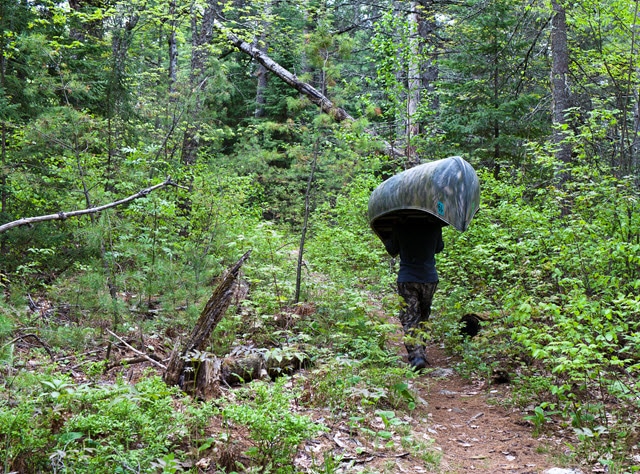
Portaging was an essential part of daily life for the people of the First Nations, or the Native Americans in what is now modern-day Canada. Historically, they used lightweight birchbark canoes whenever they were traveling.
The original portage trails followed clearings made by moose. However, as the fur trade increased, so did the need to transport heavier goods.
Portage trails became more prominent and were necessary for people to travel with their goods safely in and around water.
As they became more heavily traveled, especially as French and British settlers came to the area, these trails became towns and settlements that developed around the local economy.
When Do You Need To Portage a Canoe?
If you’re serious about canoeing, you’re going to spend a lot of time doing canoe portage. Let’s take a look at situations when canoe portage is necessary.
Crossing a Land Interruption
This is one of the most common reasons for canoe portage. For example, you’ve got to carry your canoe between parts of a body of water that are separated by land.
Avoiding Unsuitable Water
You’ll need to portage your canoe to get it across unsuitable water. For example, there may be dangerous rapids or weather changes.
Traversing an Obstruction
If you come across any kind of an obstruction (for example, a waterfall), you’ll need to portage your canoe.
Step-by-Step Guide to Canoe Portage
How you’ll carry your canoe will depend upon if you’re carrying your canoe alone, or with a friend.
Below I’ll walk you through the best technique for doing both a solo canoe portage, or for carrying a canoe with another person.
How to Do a Solo Canoe Portage
If you’re into solo canoeing (I know I am!), then there are two methods for carrying a canoe overland by yourself that you ought to learn. I’ll go over the steps involved in each method below.
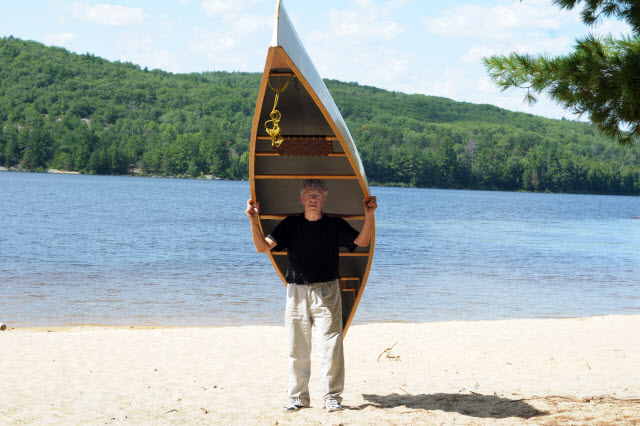
Method 1
This involves technique and skill. You don’t have to be strong for this, but you’ve got to be careful. Work hard to keep your balance and keep the canoe’s weight properly distributed.
If you don’t do this, you could end up with an injury.
So, here we go:
- Put your right hand on the yoke of the canoe.
- Balance or rest the canoe on your thigh and keep it steady.
- With your left hand, grab the outside gunnel that is away from you.
- Move your right hand grabbing the inside gunnel that is closer to you.
- Swing your body forward and backward, giving it momentum. This is where you will now have to be ready.
- When you feel like you have good momentum, swing the canoe upwards and let the yoke rest on your shoulders.
- Position your hands on each of the gunnels for balance, but the weight should be transferred onto your shoulders and down to your legs. Your arms are just used to steady the canoe.
- When taking the canoe off after your portage is complete, just maneuver the opposite way.
Method 2
- Go over to the front bow of your canoe.
- Put your left hand on the gunnel away from you, or the outside gunnel.
- Put your right hand on the gunnel nearer to you, or the inside gunnel.
- Pull from your left and swing it so it becomes upside down and you are underneath the bow. The other end of the canoe should be touching the ground in a leaning position.
- Slowly, move backward towards the yoke and balance the canoe over your shoulders.
- When taking it off the portage, just maneuver the opposite way.
Only use these two methods if you’re portaging solo. If you’re traveling with a group you can either take turns using the solo portage techniques I’ve outlined above, or you can ask for help carrying the boat. There’s no shame in that!
I’ll explain the best method for doing a tandem canoe portage in the next section.
How to Do a Canoe Portage with Someone Else
When someone else helps you with a portage, it’s called a tandem canoe portage. This kind of portage may seem easier – after all you’re splitting the weight of the canoe.
But in fact, technique and communication become extremely important with this kind of portage. Without them, this can be even more difficult than carrying a canoe overland by yourself, and you may be more susceptible to injury (or you could damage your canoe and be stranded).
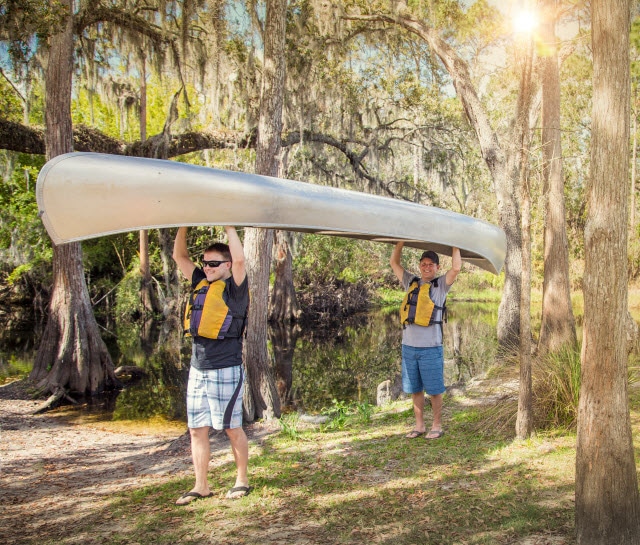
If you plan on a lengthy portage with two people, consider investing in a few additional yokes and installing them on your canoe. That lets you carry the weight on your shoulders (and not with your arms). Using your arms (as pictured above) is not recommended, as you will tire quickly and expend unnecessary energy.
If there is a height difference between the two people portaging the canoe, put the taller person in the front. This makes it easier to see by having the canoe angled up.
Here’s how to do a tandem portage, step-by-step:
- Decide who is going to be on each end of the canoe, and which direction you should be facing.
- Stand on the ends that you have agreed on.
- Stand on the same side, facing the same way.
- Assuming that the canoe is on your left, put your right hand on the inside gunnel, and the left hand on the outside gunnel. Make sure both paddlers are doing it the same way.
- Lift from the left hand and pull the canoe over your shoulders and balance it.
Communicate clearly with your partner all through the portage, from before you start to when you put the canoe down. I can tell you from experience, doing a tandem portage can be a little frustrating if you don’t do it right!
And you can end up with injuries if one of you does the wrong thing.
Proper Technique is Key
Learning the techniques is important. After all, canoe portage means lifting something heavy over your shoulder. Not to mention it’s a considerable workout.
Poor lifting techniques could result in an injury.
Also, the terrain may be uneven or there could be things like slippery rocks or wet mud. So, using the right techniques when carrying your canoe will help you maintain balance when you have your boat over your head.
Tips for an Easier Portage
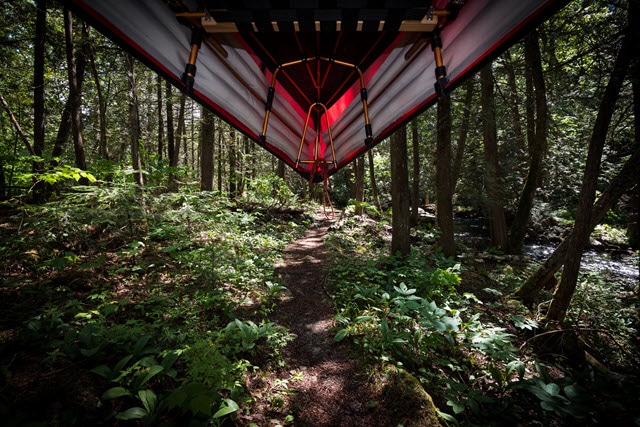
Know Your Gear
Before you go canoeing, do a quick audit of the items you’ll take with you. It will help you make a checklist of things you really need.
It will also make it clearer what items you don’t need to take along with you.
Eliminate Random Loose Things
Travel as light as possible. When you’re canoeing, only pack essentials and organize little things in a proper bag. If these things are loose and hanging, they may fall off the canoe when you portage. If you have a fishing vest or a life jacket, wear it during the portage so you have less to carry.
Also, don’t clip random things onto the canoe. Adding weight will only make portaging more difficult, and if you get your canoe out of balance it will be difficult to transport.
Planning is Everything
Make sure you know where you are going. I recommend that you scout the portage before going on it. It’s easy to jog up the trail, study the area, and jog back before you shoulder your canoe. You scout rapids before you run them, take the same approach to a challenging portage.

Plan the journey. Do your research in advance.
This way, you’re much less likely to lose your bearings and ruin your trip by getting lost.
If You’re Going With a Group, Help Each Other Out
Teamwork and communication are your watchwords. Help the other members of your group on the trail, and make sure everyone stays together.
We’ve all heard the saying, ‘there is strength in numbers’. It also ensures people don’t get lost.
Take Breaks
Portaging is hard work. Without taking breaks, you and your friends will quickly get exhausted carrying a heavy canoe. So, take as many breaks as you need.
Bring some snacks for your breaks, enough for both yourself and your companions. A little boost of energy will help you through the journey.
Have your water bottles filled up, too. After all, you’ve got to stay hydrated!
Breaks are also a great time just to breathe in the fresh air and enjoy nature. Kick back and relax for a while. And taking turns is an important part of teamwork.
Invest in a Good Yoke and Padding for the Canoe
If you’re renting a canoe, make sure that the yoke is sturdy and the padding isn’t worn out.
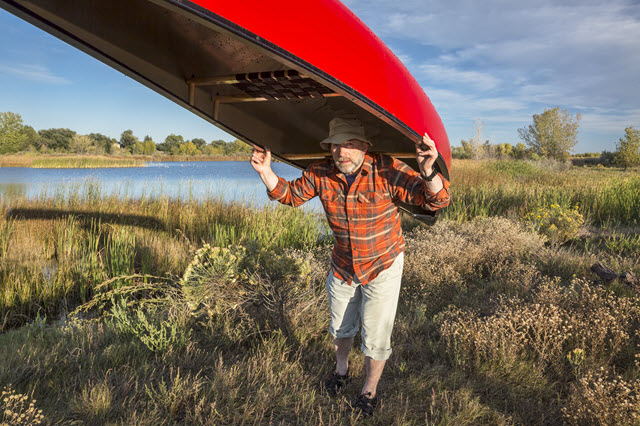
A hard yoke or worn-out padding could make your journey slightly uncomfortable when you’re portaging.
Wear Insect Repellent
Just imagine trying to swat away insects while you’re carrying a canoe! I’ve been there … it’s not practical, and without some good bug dope you’ll feel totally exposed and helpless.
Make sure you’re wearing some good insect repellent, especially on exposed arms and your neck.
If you don’t like applying it directly to your skin, get a bandana or kerchief and soak it in bug dope before you go, so you can tie it around your neck when you need it.
Be Considerate to Others on the Trail
If you’re slowing others down, move a little to the side and let them pass. It’s just basic portaging etiquette!
And others should show you the same courtesy. Also, never leave trash on the trail.
What Kind of Canoe Is Easiest to Portage?
If you haven’t bought a canoe yet, keep ease of portaging in mind before making a selection. After all, a lighter weight canoe will always be easier to portage than a heavy one.
The material from which the canoe is constructed is the most important factor in determining weight. Some of the heaviest canoes tend to be aluminum and plastic or polyethylene.
Fiberglass canoes tend to be quite lightweight, so they’re a better choice. However, Kevlar is the best material when it comes to creating an easy-to-carry canoe.
Preparing For Your Canoe Portage
To summarize, I’ll share some final thoughts and tips:
Protect yourself from injury by knowing how to correctly portage your canoe.
Spend some time practicing in advance. It doesn’t take long to get the hang of it.
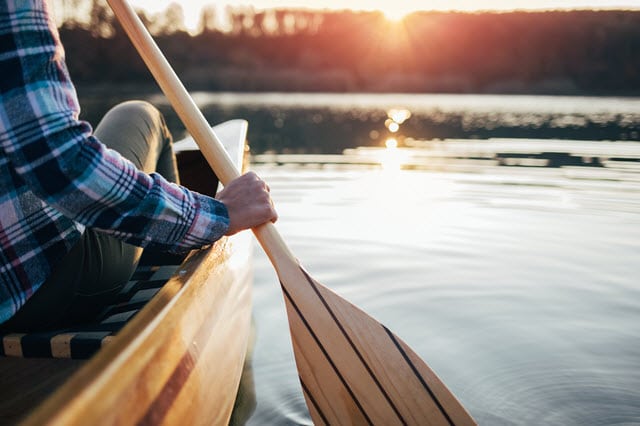
To make portaging as easy as possible, remember to:
- Use the right techniques
- Try to have a companion with you, for help
- Don’t have loose things on the canoe
- Know the area and its terrain
- Pace yourself and be cautious
- Ensure your canoe has a good yoke and padding
- Invest in a lighter weight canoe
Interested in trying kayaking after you’ve mastered canoeing? Check out my article about the differences between canoes and kayaks.
Have a fantastic time on the water, and good luck with your canoe portage!

